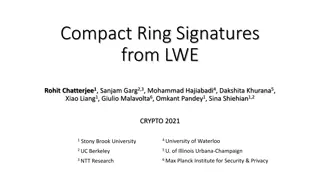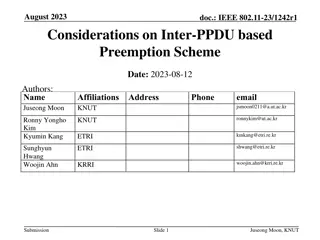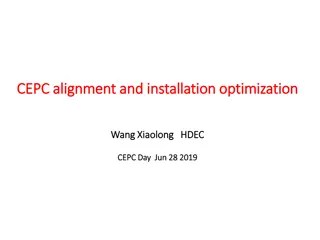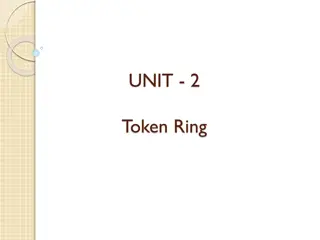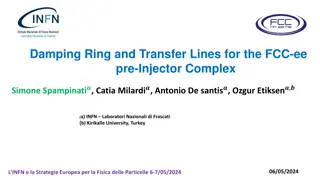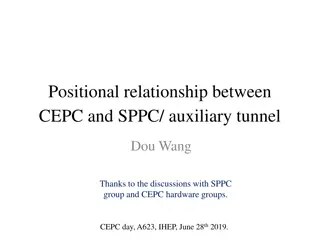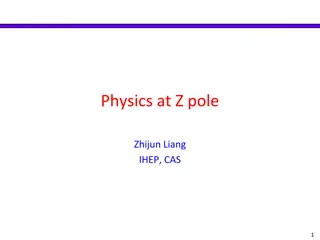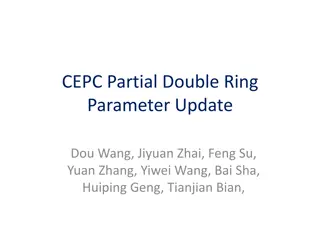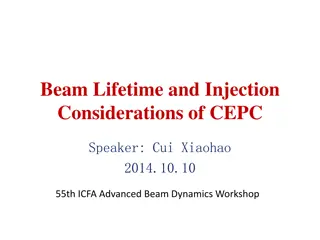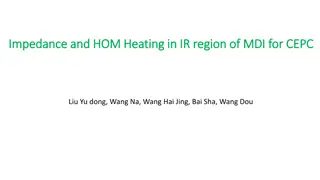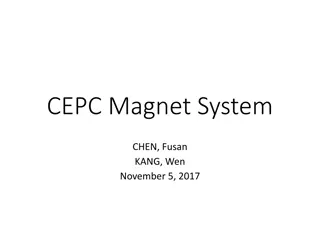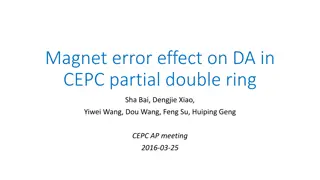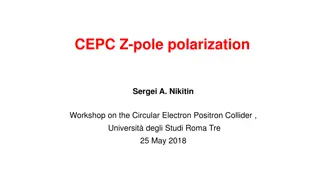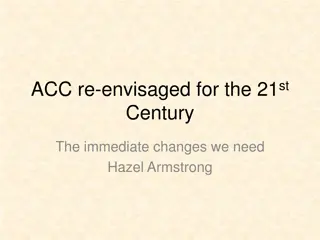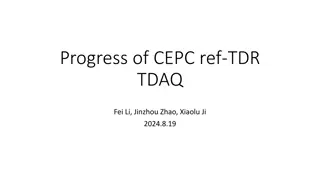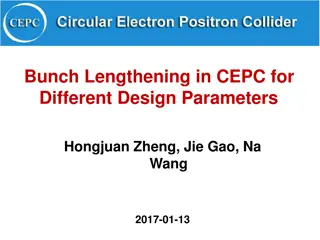Design Considerations for CEPC Double Ring Scheme
The interaction region design for the partial double ring scheme at CEPC involves primary parameters, ARC lattice structures, tune shift effects, chromaticity corrections, and optimization strategies for 3rd order chromaticity. The integration of ARC and IR components aims to enhance chromaticity control and overall performance efficiency of the accelerator.
Download Presentation

Please find below an Image/Link to download the presentation.
The content on the website is provided AS IS for your information and personal use only. It may not be sold, licensed, or shared on other websites without obtaining consent from the author.If you encounter any issues during the download, it is possible that the publisher has removed the file from their server.
You are allowed to download the files provided on this website for personal or commercial use, subject to the condition that they are used lawfully. All files are the property of their respective owners.
The content on the website is provided AS IS for your information and personal use only. It may not be sold, licensed, or shared on other websites without obtaining consent from the author.
E N D
Presentation Transcript
Interaction region design for the partial double ring scheme Yiwei Wang, Xiaohao Cui, Dou Wang, Feng Su, Sha Bai, Huiping Geng, Yuan Zhang, Jie Gao CEPC AP meeting, 19 Feb 2016
Primary parameter for CEPC double ring wangdou20160325 Pre-CDR H-high lumi. H-low power W Z Number of IPs Energy (GeV) Circumference (km) SR loss/turn (GeV) Half crossing angle (mrad) Piwinski angle Ne/bunch (1011) Bunch number Beam current (mA) SR power /beam (MW) Bending radius (km) Momentum compaction (10-5) IPx/y (m) Emittance x/y (nm) Transverse IP(um) x/IP y/IP VRF(GV) fRF(MHz) Nature z(mm) Total z(mm) HOM power/cavity (kw) Energy spread (%) Energy acceptance (%) Energy acceptance by RF (%) n Life time due to beamstrahlung_cal (minute) F (hour glass) Lmax/IP (1034cm-2s-1) 2 2 2 2 2 120 54 3.1 0 0 3.79 50 16.6 51.7 6.1 3.4 120 54 2.96 15 2.5 2.85 67 16.9 50 6.2 2.5 120 54 2.96 15 2.6 2.67 44 10.5 31.2 6.2 2.2 80 54 0.59 15 5 0.74 400 26.2 15.6 6.1 2.4 45.5 54 0.062 15 7.6 0.46 1100 45.4 2.8 6.1 3.5 0.1/0.001 0.62/0.0028 7.9/0.053 0.006 0.073 0.12 650 3.9 4.0 0.99 0.05 0.8/0.0012 6.12/0.018 69.97/0.15 0.118 0.083 6.87 650 2.14 2.65 3.6 0.13 2 6 0.23 47 0.25/0.00136 2.45/0.0074 24.8/0.1 0.03 0.11 3.62 650 3.1 4.1 2.2 0.13 2 2.2 0.47 36 0.268 /0.00124 2.06 /0.0062 23.5/0.088 0.032 0.11 3.53 650 3.0 4.0 1.3 0.13 2 2.1 0.47 32 0.1/0.001 1.02/0.003 10.1/0.056 0.008 0.074 0.81 650 3.25 3.35 0.99 0.09 1.7 0.3 1.1 0.24 0.68 2.04 0.82 2.96 0.81 2.01 0.92 3.09 0.95 3.09
ARC lattice 60/60 degree 156 cells in each section 55km
Tune shift tune vs. dP/P Second order chromaiticity arise due to stronger focusing 2 families in ARC
IR lattice Additional sextupole for 3rdorder chromaticity
Chromaticity correction 3rdorder vertical chromaticity 3rdorder vertical and horizontal chromaticity Preliminary result to be further optimized with whole ring
ARC+IR ARC 6.28nm 3rdorder vertical chromaticity ARC 2.9nm 3rdorder vertical and horizontal chromaticity
ARC+IR ARC 6.28nm 3rdorder vertical chromaticity ARC 2.9nm 3rdorder vertical and horizontal chromaticity 4 families in IR 2 families in ARC Preliminary result to be further optimized with whole ring
PDR lattice The bending angle in PDR is small compare with its length If scale bending angle with (6km/54km)*2 /4=175 mrad Actually: Left PDR 0.75mrad+14.25mrad-15mrad-15mrad Actually: Right PDR +15mrad +15mrad-14.25mrad-0.75mrad Present PDR almost doesn t contribute to the emittance The PDR should be included into the ARC, otherwise the total length will be 55km+6km!!!



